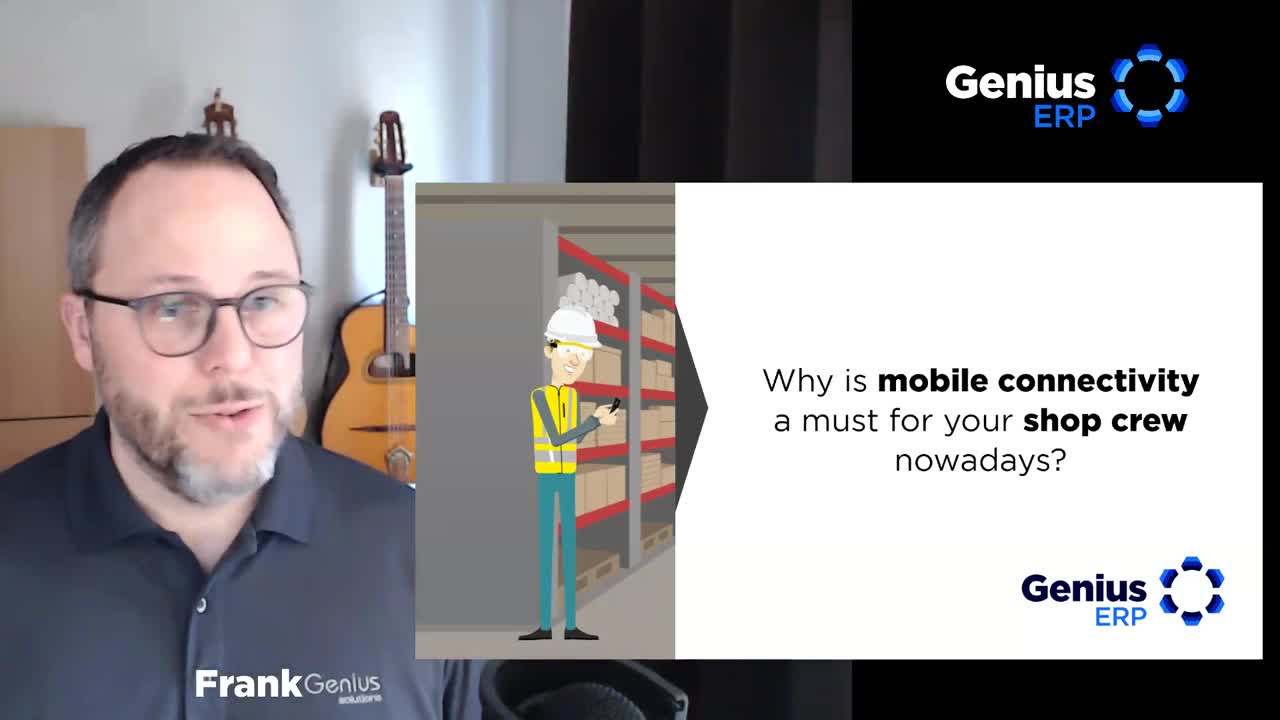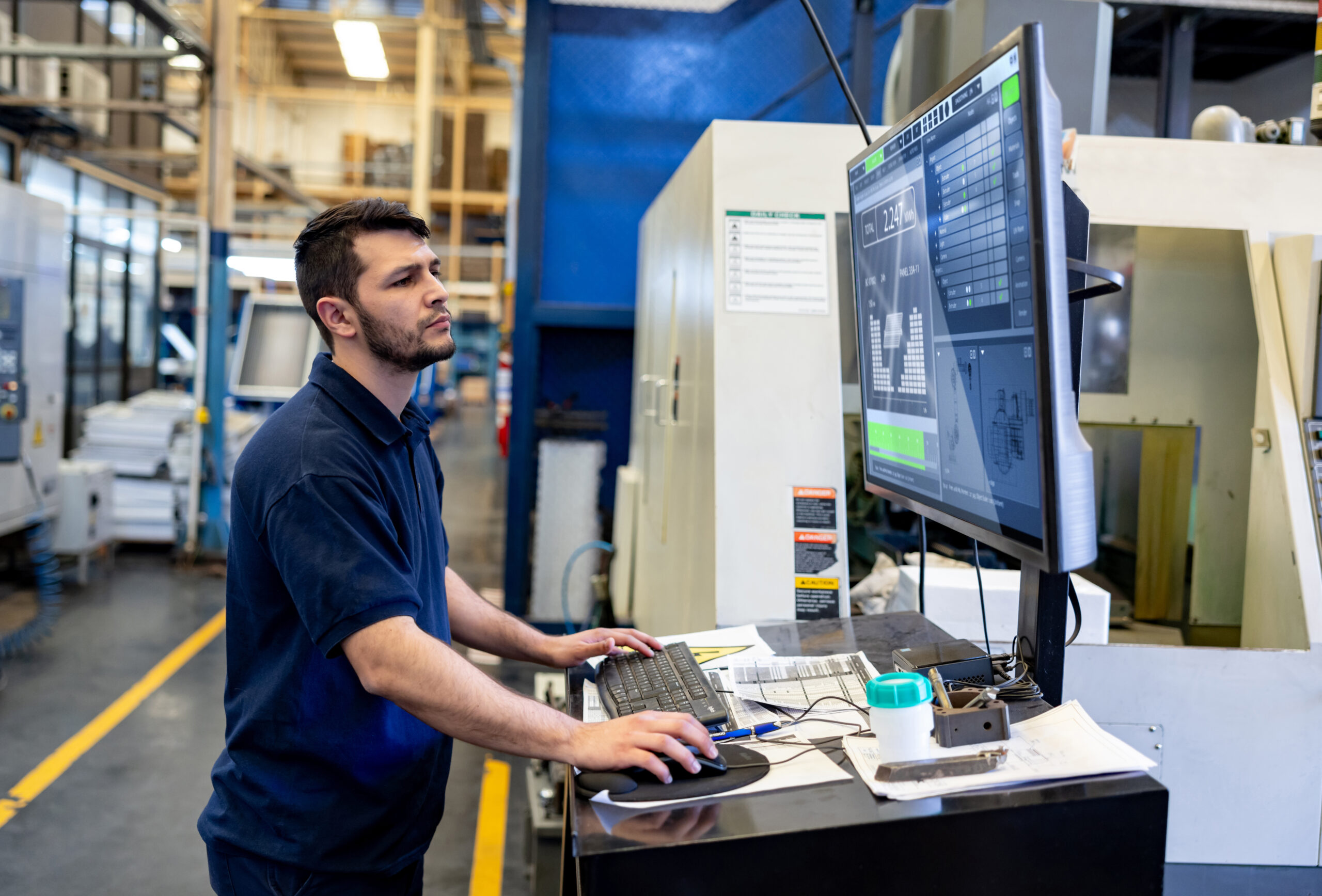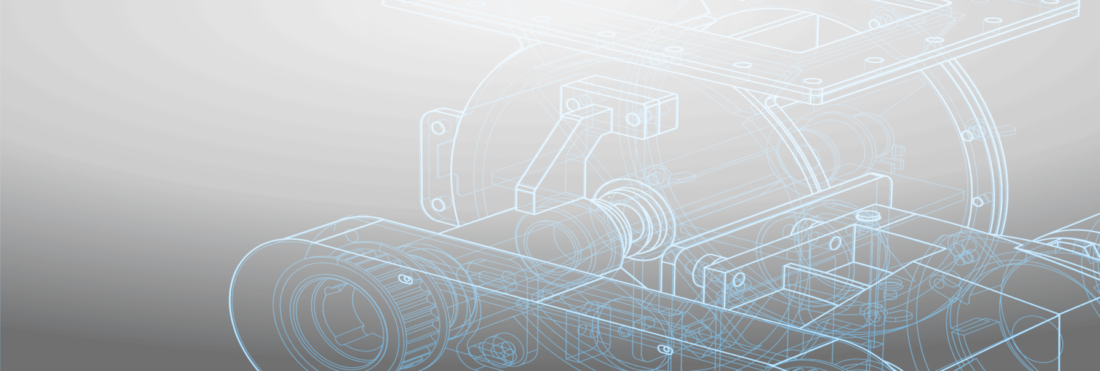
What’s in it for me?
Discover how integrating ERP systems with mobile devices can transform shop floor operations and lead to cost savings, improved performance, faster workflows and optimized resource use. Learn how to adopt mobile technology in your manufacturing operations to empower your shop floor.
Read the transcript
All right, hi, I’m Frank. I’ve been with Genius for about nine years, a bit more than that. I started by doing implementation here at Genius ERP and then moved my way to doing migration management. I also help out customers during Q&A sessions and assist New Prospects in deciding which ERP they should be moving into. That led me to be doing webinars for about four years now at Genius on a regular basis. So, I’ll be happy to be your host today. If there are any questions, because of the amount of participants today, I’m going to ask you to write your questions or comments in the Q&A section. That will allow me to see if there is traffic and if I need to stop the presentation to answer your questions. But we will have a question and answer session at the end of the session, so welcome. Thank you for joining.
Alright, the topic today: Why is mobile connectivity a must for your shop crew nowadays? So, needless to say, we’ll go into a few topics. Let me hit the agenda and start this webinar for today.
Alright, first step, we’re going to go through a little introduction on Genius. And let me just say from the start, we’ve done this on a regular basis, some of you are recurring, so I’ll make it short. You can plan for about 30 to 40 minutes for the content of the webinar. And the first three topics are going to be pretty quick. The fourth topic is really where we’re going to spend most of our time. So again, who’s Genius? Number two, modern business operations. Yeah, I was fighting to get a good title in there. Really what I’m going to be referencing is where we got to today, the era of digitalization, of mobile tools connecting people to machines to data. That’s the gist of the presentation today.
The third point we want to talk about is resistance to onboarding into those new technologies in a lot of small and medium enterprises. And we’ll discuss that just a little bit because we do face that even at Genius here.
Then, shop crew takeaways. We’re going to go through some of the key roles from shop employees and how they can leverage mobile connectivity to do their day-to-day work. And what are the key benefits or takeaways for these roles, and how it’s just a must nowadays. And for sure, we’ll have questions at the end. So again, hit me with your questions in the Q&A, write down your questions. If we have time, I’ll open the mics at the end, we can have a quick conversation as well.
Alright, let’s head into about Genius, who we are here at Genius. So let me put this full screen here. I can probably just move my face here. Perfect.
So, 30-plus years in business. I think I’ve been showing this slide for like four years in a row, so it’s probably 30 to 34 years. We’re now at 120-plus employees and we have tens of thousands of users. You can see our footprint here in red all across North America. We even have small dots around there, but that’s really our focus. That’s the heart shape. 96% retention. That means our customers are staying with us year after year, month after month. That’s really a feather in our cap if you compare it to the rest of the industry where people are moving from ERP to another or from one type of system to another. So we’re pretty proud of that retention of customers.
25% combined growth year after year. Been doing webinars for four years, and I think that’s been on there as such as the 96% retention at the same time.
Alright, so here we can see some different badges that were awarded to Genius from different websites that help you select which ERP to use for your business. Front runner, high performers, stuff like that. But probably where I want to take your attention is right there on top. There’s a graph talking about how easy the software is to use and kind of satisfaction versus ease of use. And we rank pretty high even compared to bigger competitors in the ERP.
What makes this unique? What would make you use Genius compared to other ERPs? I’ll turn that around. What are typically our customers that use Genius? Our focus is really around people that make unique products every time. So, you’re either engineering to order, configuring to order, so you might have a similar product or always the same kind of equipment, but it always gets out of the shop in some kind of weird, different way, unique way, I should say. Make-to-order businesses. And that brought us to have some features that will serve well that industry. Just mentioned configurator, for example, but there’s the CAD-to-BOM tool that integrates design software straight into the ERP to bring information about materials and structure scheduling. Quite a few ways of scheduling, and it’s very flexible. And access to data with dashboards, business intelligence.
Alright, so this is where I wanted to be at this point. I’ve thrown on screen a map of the shop. Right in the middle of that big slate is the shop floor, and all around it are activities supporting the shop floor. This is how I like to see Genius, and that’s the point of this slide. Every red dot you see on the screen are functionalities or roles that we cover in Genius with our functionalities. So, if you’re looking for an ERP today and you’re new to the ERP world, this is kind of the coverage in a quick glimpse of Genius ERP. And if you are a customer of ours, by the way, take a minute, look at the slide. I’m pretty sure you’re going to find something that you didn’t even know that Genius would offer you. Alright, so you can always pause that if you want to go back to the recording. Let’s get into some of the topics here.
So, modern business operation. How did we get where we are today? Don’t worry, I’m not going to do a whole episode on history and all that, but I’ll do a quick 30 seconds, at least. So, the first thing that comes to mind is we are living, and we’ve lived for the last 30, 40 years, a rough exponential or crazy revolution of digitalization. Where did that start? It started a couple of years ago, I should say centuries ago, and then 19, was it 1700 or something, where we had the mechanization that came into play. Back then, we probably used a whole lot of paper to do work in the shop. And then it evolved. It got to a point where we had production lines and more mechanics involved and more electricity involved in shop businesses, and that’s probably more in the 1800s. And then we got to a point in the 1970s where we had the automation phase, that’s the 3.0 industry revolution, and I’m more or less correct for the years, if you look at the bottom here. I’m showing kind of evolving from paperwork to clock stations to scanning devices or the scanning paper on the shop floor. But you can see that shop floor tools have evolved through the years. And needless to say, today, we’re in the fourth revolution, the 4.0 manufacturing, Internet of things, paperless, machine learning, connectivity. There’s so many words for it. So, in nutshell, we’ve brought technology to the table and we’ve applied it into so many areas of business. So, current landscape, we can see digitalization on across the board. Today, just 20 years ago, I’m not I don’t want you to push back as far as my other graph was showing to you. Just think about the last 20 years. Technology has made its way to retail business, healthcare, finance, for sure, manufacturing. You can see my little slide on ERP here, having everything connected. That’s definitely the topic for today. But just broader picture here, technology is everywhere. It’s evolving. And just as even if you look at the black couple of years, the curve is always exponential so far on how people are onboarding and more mature about technology.
Alright, small and medium business and how we see resistance to change on adopting the mobile technology and solution for their shop crew. So, what kind of pushback do we hear typically? Well, the classic one is expertise. We hear this when we start talking to new customers implementing the software. “Well, my employees aren’t really ready for this. I don’t feel they can take that on.” Well, you’d be surprised. In today’s world, we see a whole lot of people, even with the younger group coming on board, I mean, there are people from the next generation joining into management, administration, shop floor employees everywhere, and you can clearly see they turn around and they wonder, “Why can’t I just take my phone and see this?” So, they’re, I guess, they’re ready sometime before the technology is even ready to hit certain functionalities. So, I think people are ready. Cost. Well, we think about investing into recent technology. I mean, there’s never been a better moment to have an easy entry market-type device that will have full coverage, we’ll have a browser, we’ll have Wi-Fi, or whatsoever you need to be connected at a low cost. So, if you compare that to maybe an old clocking machine or all the paperwork and administration fees around that, the return on investment is clear. Well, I didn’t want to jump the gun on my last point here, return on investment. Well, that’s kind of the topic for today’s discussion. We’re going to move into all the benefits and why going into being connected and having people interacting, I mean, might be for efficiency, for cohesion of teams, for faster decision-making. We’ll talk about all these points in the rest of the presentation, but typically when there’s pushback, it’s very easy to tell our customers or to onboard people into using these technologies.
Oh, I forgot about that one. Okay, I’m kind of restating some of the things we’ve already said, but I mean, the trend in today’s world is people, users already. I was telling you that already. And you can think about this. Maybe that’s a good time to get a small glimpse in storyline. Twenty years ago, I was already in the ERP business, and back then, we were still facing companies that weren’t even ready for ERPs. There were so many solutions out there, a lot of them failed back then, but now the products are more mature, people are more mature about it too. People are looking for the technology to be embedded into their business more than ever. So again, just 20 years ago versus like 10 years ago, there’s already a huge difference, and I’d say in the last 10 years, what we’re seeing more and more is the mobile, the digitalization of every role. I’ve written down here “environment ready.” So, we’re thinking here hardware, devices, they’re more stable, they’re more accessible. I’d say we can even talk about networks and the way they work and the way you can connect any device to a network today very easily. The other thing is technology ready. Here, I’m thinking more about maybe not on the user side, but on the developer side. Think about us here at Genius
We can see the two aspects here: we have either more of a mobile interface or more of a tablet-type interface. On the mobile interface, somebody can just go up to the shelf, scan his or her work order. In the case of the picture before, it would tell the person where they are, some of these products, and which location they are available, and they can just pick and save from that device, and that would deplete inventory live. Same thing if we have somebody going around and tackling a list of components to kit or to bundle into this cart and bring it to production. Well, we have this list, a complete list in front of them on a tablet where it’s already sorted by location, meaning this is already an optimized route. You’re going to go near Row one, you want to pick everything that’s there before going to the other side of the shop floor and coming back. So really, this is optimizing your route by just sorting it by location. The other thing you can right away see, we were talking about connectivity earlier, look at the green color button. If it’s partial, it would be yellow, and if it’s not available, it would be so. Remember, when receiving a confirmed transaction and increased inventory, your buttons would change color in real-time. So really, we’re talking about connectivity and cohesion in the team, and probably way more way less of times.
Okay, so again through that tablet, you can cherry-pick, deplete your inventory as you’re creating your bins, or just click on a button that says pick all, and you’re done. Next step is fabrication. Let’s talk about the workers themselves. Again, they could go out themselves and go pick what they need from the inventory. They will have control to do that on the interface, but first of all, I’m going ahead of myself. Who are operators, assembly workers, welders, fabricators? I’ve tried to take a few pictures, and I had fun here. In the middle, I kind of gave you good old manpower that I’m talking about here. The most important point typically is, I want to record time, I want to record labor to have proper costing as an administrator, but as a worker, what’s key here is feed me information so I know what I have to do. I don’t have to look for it. So really, this is where we want to go. Somebody that needs to cut to bend metal, is the metal available? Is it my turn to work, or is it still at the laser station? I need to see some instruction. Where does the hole go? What kind of die should I use? All of this.
So let’s flip it over to the main interface. So again, we’ve planned this interface to be interactive, dynamic. So think about this like a McDonald’s screen. So you’re working at the burger station and you have to do, I don’t know, one Big Mac, one… What do you call it, McChicken or whatever it is. I’m not that big of a fan of McDonald’s. So the important thing that I want to mention by that is these are in order of priority. So when you hit this screen, you know what you’re supposed to be working on next. And on top of that, it’s already filtered. Remember what I said, if I’m missing components, I don’t want to start working on it to find out later that I’m a few components short and I’m going to have to stop halfway incomplete. So again, filtering dynamically with everybody else’s work. And on screen, you can see where I have my material on hand. Next step is going to cutting, for example, and on top of that, if I need to visualize instruction, I can see attached document, drawing, design. So we’re going away from the paper packets and all this. We can go almost paperless with this if you want or full paperless if you want. And on top of that, it’s not just recording, viewing documents. You can record pictures against it. You’re with your tablet right now, so take a picture, record it against your task, keep proof log, nonconformities if you need. There’s even an inspection checklist that we can pop from there if we want to.
Next thing you’re going to tell me is, “Wow, that screen looks complicated. I don’t think my employees are going to be ready for this.” Remember that statement earlier? We do get this, and I guess quite often there is still a lot of, “Well, I’m old so I’m going to criticize my own self by saying there are some people not as technology ready and might see this as a bit of an endeavor.” So we do have a very simplified version of this where we can still use paper travelers, work orders if you want to call them. So the screen is really dumbed down, and the only thing you need to do is scan your work order, you’re up to work. Come back to the station, done with that work, confirm your time entry, and just scan the next thing and you’re up to work. So it’s all scanning, no buttons, no interaction, very, very quick and easy to use. So if you are still thinking that, “Hmm, not sure my workers are ready for this,” there is still a quick and easy-to-use tool that will still get you that time recording or step completion or where we’re at in the shop.
Alright, really bulling through this half an hour. Not bad. So what I didn’t say I’m missing here when we go through that shop interface as we are entering our time, we can also do the work order completion. We can say we are done. So if I was, I don’t know, doing a polish on a final component, verify the dimension, everything’s good,
Get your eBook Scared to implement a new ERP?
"*" indicates required fields



